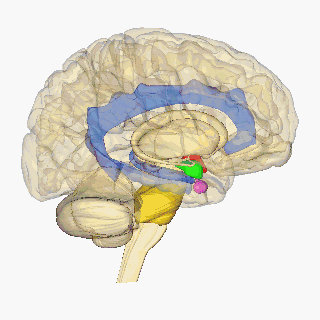Related Research Articles

The visual cortex of the brain is the area of the cerebral cortex that processes visual information. It is located in the occipital lobe. Sensory input originating from the eyes travels through the lateral geniculate nucleus in the thalamus and then reaches the visual cortex. The area of the visual cortex that receives the sensory input from the lateral geniculate nucleus is the primary visual cortex, also known as visual area 1 (V1), Brodmann area 17, or the striate cortex. The extrastriate areas consist of visual areas 2, 3, 4, and 5.

Grey matter, or brain matter in American English, is a major component of the central nervous system, consisting of neuronal cell bodies, neuropil, glial cells, synapses, and capillaries. Grey matter is distinguished from white matter in that it contains numerous cell bodies and relatively few myelinated axons, while white matter contains relatively few cell bodies and is composed chiefly of long-range myelinated axons. The colour difference arises mainly from the whiteness of myelin. In living tissue, grey matter actually has a very light grey colour with yellowish or pinkish hues, which come from capillary blood vessels and neuronal cell bodies.
Human intelligence is the intellectual capability of humans, which is marked by complex cognitive feats and high levels of motivation and self-awareness. Using their intelligence, humans are able to learn, form concepts, understand, and apply logic and reason. Human intelligence is also thought to encompass their capacities to recognize patterns, plan, innovate, solve problems, make decisions, retain information, and use language to communicate.
Alien hand syndrome (AHS) or Dr. Strangelove syndrome is a category of conditions in which a person experiences their limbs acting seemingly on their own, without conscious control over the actions. There are a variety of clinical conditions that fall under this category, which most commonly affects the left hand. There are many similar terms for the various forms of the condition, but they are often used inappropriately. The affected person may sometimes reach for objects and manipulate them without wanting to do so, even to the point of having to use the controllable hand to restrain the alien hand. Under normal circumstances however, given that intent and action can be assumed to be deeply mutually entangled, the occurrence of alien hand syndrome can be usefully conceptualized as a phenomenon reflecting a functional "disentanglement" between thought and action.

Brodmann area 23 (BA23) is a region in the brain that lies inside the posterior cingulate cortex. It lies between Brodmann area 30 and Brodmann area 31 and is located on the medial wall of the cingulate gyrus between the callosal sulcus and the cingulate sulcus.

Polymicrogyria (PMG) is a condition that affects the development of the human brain by multiple small gyri (microgyri) creating excessive folding of the brain leading to an abnormally thick cortex. This abnormality can affect either one region of the brain or multiple regions.
Neuroscience and intelligence refers to the various neurological factors that are partly responsible for the variation of intelligence within species or between different species. A large amount of research in this area has been focused on the neural basis of human intelligence. Historic approaches to studying the neuroscience of intelligence consisted of correlating external head parameters, for example head circumference, to intelligence. Post-mortem measures of brain weight and brain volume have also been used. More recent methodologies focus on examining correlates of intelligence within the living brain using techniques such as magnetic resonance imaging (MRI), functional MRI (fMRI), electroencephalography (EEG), positron emission tomography and other non-invasive measures of brain structure and activity.

The angular gyrus is a region of the brain lying mainly in the posteroinferior region of the parietal lobe, occupying the posterior part of the inferior parietal lobule. It represents the Brodmann area 39.
Neuroplasticity, also known as neural plasticity or brain plasticity, is the ability of neural networks in the brain to change through growth and reorganization. It is when the brain is rewired to function in some way that differs from how it previously functioned. These changes range from individual neuron pathways making new connections, to systematic adjustments like cortical remapping or neural oscillation. Other forms of neuroplasticity include homologous area adaptation, cross modal reassignment, map expansion, and compensatory masquerade. Examples of neuroplasticity include circuit and network changes that result from learning a new ability, information acquisition, environmental influences, pregnancy, caloric intake, practice/training, and psychological stress.
The size of the brain is a frequent topic of study within the fields of anatomy, biological anthropology, animal science and evolution. Measuring brain size and cranial capacity is relevant both to humans and other animals, and can be done by weight or volume via MRI scans, by skull volume, or by neuroimaging intelligence testing. The relationship between brain size and intelligence remains a controversial although frequently investigated question.
Akinetic mutism is a medical condition where patients tend neither to move (akinesia) nor speak (mutism). Akinetic mutism was first described in 1941 as a mental state where patients lack the ability to move or speak. However, their eyes may follow their observer or be diverted by sound. Patients lack most motor functions such as speech, facial expressions, and gestures, but demonstrate apparent alertness. They exhibit reduced activity and slowness, and can speak in whispered monosyllables. Patients often show visual fixation on their examiner, move their eyes in response to an auditory stimulus, or move after often repeated commands. Patients with akinetic mutism are not paralyzed, but lack the will to move. Many patients describe that as soon as they "will" or attempt a movement, a "counter-will" or "resistance" rises up to meet them.

In neuroanatomy, the parieto-occipital sulcus is a deep sulcus in the cerebral cortex that marks the boundary between the cuneus and precuneus, and also between the parietal and occipital lobes. Only a small part can be seen on the lateral surface of the hemisphere, its chief part being on the medial surface.

The posterior cingulate cortex (PCC) is the caudal part of the cingulate cortex, located posterior to the anterior cingulate cortex. This is the upper part of the "limbic lobe". The cingulate cortex is made up of an area around the midline of the brain. Surrounding areas include the retrosplenial cortex and the precuneus.

In human neuroanatomy, brain asymmetry can refer to at least two quite distinct findings:
The following outline is provided as an overview of and topical guide to human intelligence:

The neuroscience of sex differences is the study of characteristics that separate brains of different sexes. Psychological sex differences are thought by some to reflect the interaction of genes, hormones, and social learning on brain development throughout the lifespan. A 2021 meta-synthesis led by Lise Eliot found that sex accounted for 1% of the brain's structure or laterality, finding large group-level differences only in total brain volume. A subsequent 2021 led by Camille Michèle Williams contradicted Eliot's conclusions, finding that sex differences in total brain volume are not accounted for merely by sex differences in height and weight, and that once global brain size is taken into account, there remain numerous regional sex differences in both directions. A 2022 follow-up meta-analysis led by Alex DeCasien analyzed the studies from both Eliot and Williams, concluding that "The human brain shows highly reproducible sex differences in regional brain anatomy above and beyond sex differences in overall brain size" and that these differences are of a "small-moderate effect size." A review from 2006 and a meta-analysis from 2014 found that some evidence from brain morphology and function studies indicates that male and female brains cannot always be assumed to be identical from either a structural or functional perspective, and some brain structures are sexually dimorphic.

Aron Keith Barbey is an American cognitive neuroscientist, who investigates the neural architecture of human intelligence and brain plasticity. Barbey is the Emanuel Donchin Professorial Scholar of Psychology and a Professor of Psychology, Neuroscience, and Bioengineering at the University of Illinois. He is director of the Decision Neuroscience Laboratory at the Beckman Institute for Advanced Science and Technology, and founding director of the Center for Brain Plasticity at the Beckman Institute, where he leads the Intelligence, Learning, and Plasticity (ILP) Initiative.
The parieto-frontal integration theory (P-FIT) considers intelligence to relate to how well different brain regions integrate to form intelligent behaviors. The theory proposes that large scale brain networks connect brain regions, including regions within frontal, parietal, temporal, and cingulate cortices, underlie the biological basis of human intelligence. These regions, which overlap significantly with the task-positive network, allow the brain to communicate and exchange information efficiently with one another. Support for this theory is primarily based on neuroimaging evidence, with support from lesion studies. The P-FIT is influential in that it explains the majority of current neuroimaging findings, as well as increasing empirical support for cognition being the result of large-scale brain networks, rather than numerous domain-specific processes or modules. A 2010 review of the neuroscience of intelligence described P-FIT as "the best available answer to the question of where in the brain intelligence resides".
The neural efficiency hypothesis proposes that while performing a cognitive task, individuals with higher intelligence levels exhibit lower brain activation in comparison to individuals with lower intelligence levels. This hypothesis suggests that individual differences in cognitive abilities are due to differences in the efficiency of neural processing. Essentially, individuals with higher cognitive abilities utilize fewer neural resources to perform a given task than those with lower cognitive abilities.
Rex Eugene Jung is an American psychologist who has researched on the neural basis of human intelligence and creativity. He is an assistant professor at the University of New Mexico, where he is the director of neuropsychological services. Jung is also a practicing psychologist at his private clinic.
References
- ↑ "Closing the achievement gap the intelligent way". Times Higher Education. 2017-04-06. Retrieved 2017-09-04.
- ↑ Gottfredson, Linda (December 13, 1994). "Mainstream Science on Intelligence". Wall Street Journal , p. A18.
- ↑ Jung, Rex E.; Haier, Richard J. (April 2007). "The Parieto-Frontal Integration Theory (P-FIT) of intelligence: converging neuroimaging evidence". The Behavioral and Brain Sciences. 30 (2): 135–154, discussion 154–187. doi:10.1017/S0140525X07001185. ISSN 0140-525X. PMID 17655784. S2CID 14699011.